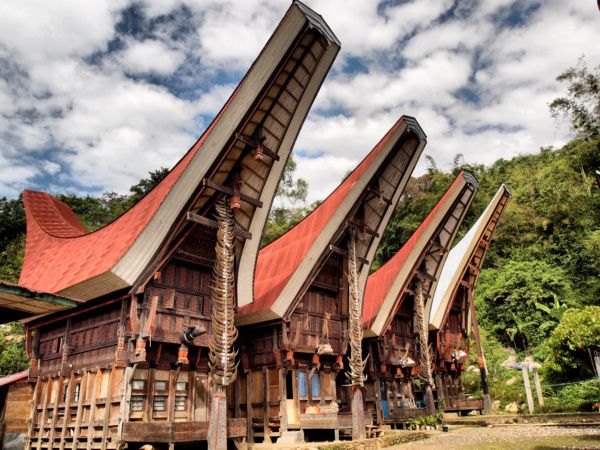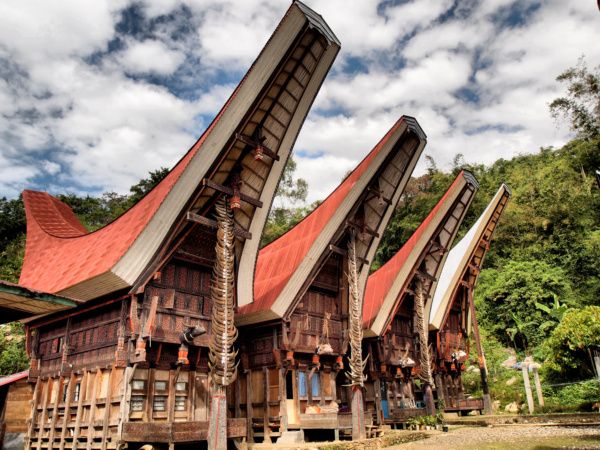
What is Tongkonan?
Tongkonan is more than a traditional Torajan house. It is a sacred space—built not only for shelter but as a vessel of culture, history, and ancestral connection. Located in the lush highlands of Tana Toraja, South Sulawesi, this house stands as a symbol of status, spirituality, and shared identity.
Each Tongkonan tells a story—through its carved panels, its colors, its orientation, and even its roof.
The Origin of Tongkonan in Toraja Culture
A Myth from the Ancestors
According to local belief, the first Tongkonan came from the heavens. The Torajans believe their ancestors descended to Earth and brought the design with them. That’s why the word Tongkonan comes from tongkon, meaning “to sit” — a place for gathering, leadership, and legacy.
Historical Role of Tongkonan
Historically, the Tongkonan was the center of governance, rituals, and family decisions. Even today, it functions as a symbol of social hierarchy, spiritual strength, and family unity.
The Unique Architecture of a Tongkonan House
The Roof Like a Boat or Buffalo Horns
The most iconic feature of Tongkonan is its saddle-shaped roof, curving dramatically upward like buffalo horns or a traditional boat (perahu). This isn’t just for style—it reflects the Torajan belief in cosmic harmony and ancestral protection.
The roof always faces north, symbolizing the connection to the Puya (afterlife).
Structure and Sacred Orientation
Each Tongkonan consists of three levels:
- Roof: symbolic of the divine and spirit world
- Living space: the human world
- Pillars below: connection to nature and ancestors
The northern part of the house is reserved for guests and rituals. The southern side is where daily life happens.
Symbolic Carvings and Colors in Tongkonan
Carvings with Deep Meaning
The wooden panels of Tongkonan are filled with traditional Torajan motifs, each one representing something deeper:
- Pa’tedong (buffalo horns): strength, wealth
- Pa’ssussu (bamboo): growth, humility
- Sun/star shapes: guidance from above
- Spirals and lines: life journey and eternity
These carvings are more than decoration—they are visual language, passed down through generations.
Colors of Power and Spirit
Tongkonan is painted in bold, sacred colors:
- Red = blood, life
- Black = death, mystery
- White = purity, soul
- Yellow = divine blessings
Together, these colors tell the story of life and death according to Toraja cosmology.
Tongkonan and Social Structure
A House That Shows Your Status
Not all Tongkonan are the same. Large, ornate Tongkonan with many carvings and buffalo horns show that the family is noble or wealthy. Simpler homes belong to commoners.
Buffalo horns mounted on the front poles represent past sacrifices—each one a badge of honor.
Family Ownership and Inheritance
A Tongkonan is owned not by individuals, but by entire families. Decisions are made collectively. This reinforces the Torajan value of kinship and shared responsibility.
Tongkonan in Toraja Ceremonies
Rambu Solo’ and Rambu Tuka’ Rituals
The Tongkonan plays a central role in Torajan ceremonies:
- Rambu Solo’: funeral ceremonies. The house becomes a spiritual station, where the soul begins its journey to the afterlife.
- Rambu Tuka’: celebration of life, house blessings, or harvests.
Without the Tongkonan, these rituals cannot be properly performed.
Link Between the Living and Ancestors
Torajans believe their ancestors are always watching. Through offerings, chants, and rituals performed in the Tongkonan, families keep this sacred connection alive.
Modern Challenges and Preservation
Between Tradition and Modern Life
Modernization has brought changes. Young people move to cities. Traditional building materials are expensive. Some Tongkonan are abandoned or replaced by concrete houses.
But losing the Tongkonan means losing a living part of Toraja identity.
Cultural Tourism as a Solution
Today, cultural tourism is helping preserve Tongkonan. Visitors come from around the world to see authentic Torajan architecture. Villages like Kete Kesu and Pallawa now offer guided tours, workshops, and even homestays in traditional Tongkonan.
By sharing their culture, Torajans are keeping it alive.
Conclusion: Tongkonan is More Than a House
Tongkonan is a cultural treasure. It reflects the deep spiritual, social, and historical fabric of Torajan society. Each Tongkonan is a silent storyteller—revealing the values, struggles, and beliefs of its people.
When you stand before a Tongkonan, you’re not just looking at a house—you’re standing before a monument of memory and identity.
✅ Planning to Visit Toraja?
Don’t miss the chance to visit traditional villages with well-preserved Tongkonan houses. Learn more about our Toraja tour packages here to explore the culture, rituals, and landscapes of Tana Toraja.

